Interior design in the Japanese style fascinates with its brevity and simplicity. But at the same time, it is filled with deep philosophy of Japanese culture and religion.

This style is suitable not for everybody, because a man who is accustomed to the Western design, may not be very convenient to use the room in Japanese style. Traditional Japanese style in interior design requires compliance with certain color palette, use of natural materials and avoiding impractical items and accessories. It requires a completely different type of perception and use of space. Japanese style suggests a lack of the usual for us interior items - chairs, sofas, chairs and beds on legs. This is quite unusual, because you need to sit on the floor, and it can be uncomfortable for many people.
Today, therefore, in the interior design often used is not a traditional Japanese style, and its styling. This creates a pleasant and easy atmosphere in Japan, but for us to maintain a good interior.

When designing Japanese-style necessary to examine its features:
• Practicality and minimalism. The interior uses only practical things that are really needed tenant. Excluded personalized items (pictures, statues, paintings, crocheted napkins, souvenirs).
• Some koloristka. Use restrained pastel colors. Moreover, primary colors should be no more than three. Excluding bright and colorful objects.
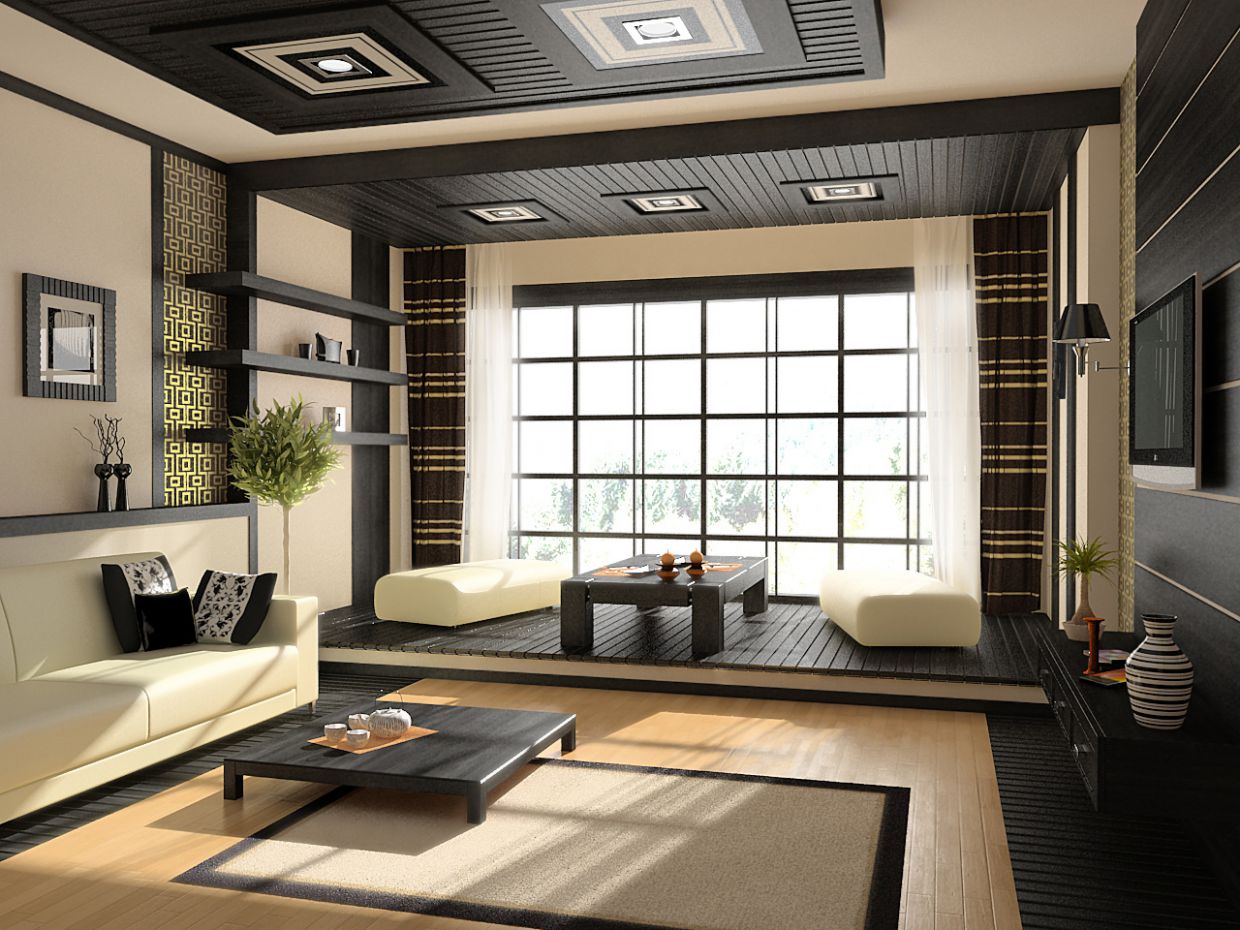
• The space and lighting. Rooms should be spacious, with a minimum of furniture. Lighting - muted. As a lamp or chandelier uses traditional lanterns made of rice paper - "futon". To split the screen space is used.
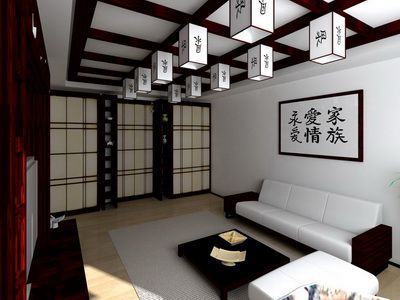
• Materials. The decor should give preference to natural materials (natural fabrics, rice paper, wood, clay, leather).
These features should be considered, even if you create a stylized Japanese interior, deviating from strict adherence to the rules.
How to connect the Japanese style with a familiar comfort to us?
For this classic Japanese interior is adapted to the style of life of Europeans: added decorative elements and furniture to slightly modify, increase the range of colors in the design. To create the proper atmosphere is not required to adhere to clearly defined standards, enough to make the project a few typical design elements of the interior.
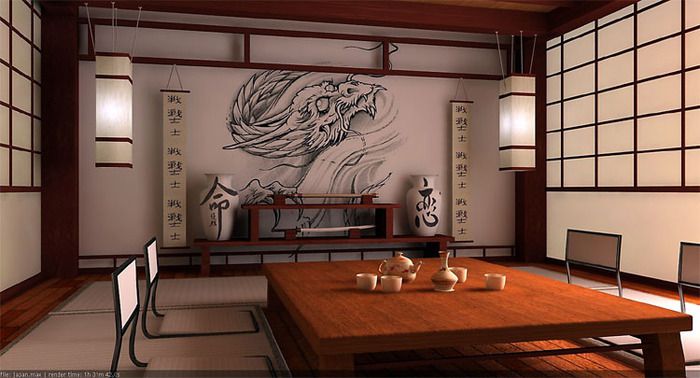
The main modifications to the traditional Japanese style of modern interior:
- The design appear accessories, pictures, pillows and panels with hieroglyphics. But these elements should not be too much - because the space should seem easy and not overloaded with unnecessary items decor;
- Low mattress replaces the more comfortable furniture - stylized bed or sofa. To maintain the principle of practicality, in the interior used closets or podium with drawers, which can hide the rarely used items;
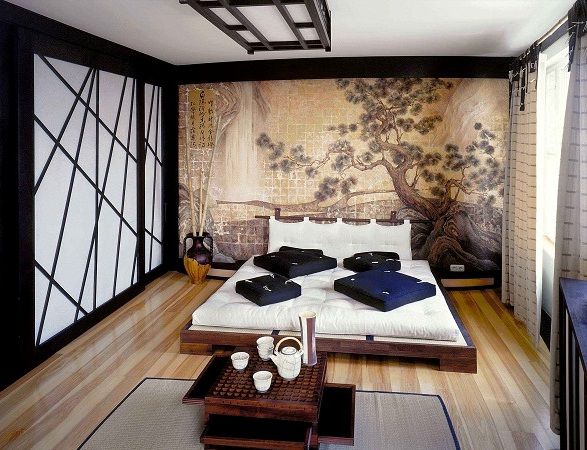
- Changing colors. Natural, soft colors can be replaced by warmer or mottled. There are also bright accents on certain subjects;
- The windows can be used, or conventional roller blinds made of natural fabrics with fine monotonous pattern;
- Some interior items lose their functionality and become decorative elements - screens, ottomans for sitting on the floor, small tables for tea ceremonies. They no longer carry their original functions, and help to create a certain atmosphere.
Thus, when you create a Japanese interior styling is important to convey brevity and minimalism of Japanese culture and at the same time maintain the familiar to Europeans comfort.

This style is suitable not for everybody, because a man who is accustomed to the Western design, may not be very convenient to use the room in Japanese style. Traditional Japanese style in interior design requires compliance with certain color palette, use of natural materials and avoiding impractical items and accessories. It requires a completely different type of perception and use of space. Japanese style suggests a lack of the usual for us interior items - chairs, sofas, chairs and beds on legs. This is quite unusual, because you need to sit on the floor, and it can be uncomfortable for many people.
Today, therefore, in the interior design often used is not a traditional Japanese style, and its styling. This creates a pleasant and easy atmosphere in Japan, but for us to maintain a good interior.

When designing Japanese-style necessary to examine its features:
• Practicality and minimalism. The interior uses only practical things that are really needed tenant. Excluded personalized items (pictures, statues, paintings, crocheted napkins, souvenirs).
• Some koloristka. Use restrained pastel colors. Moreover, primary colors should be no more than three. Excluding bright and colorful objects.

• The space and lighting. Rooms should be spacious, with a minimum of furniture. Lighting - muted. As a lamp or chandelier uses traditional lanterns made of rice paper - "futon". To split the screen space is used.

• Materials. The decor should give preference to natural materials (natural fabrics, rice paper, wood, clay, leather).
These features should be considered, even if you create a stylized Japanese interior, deviating from strict adherence to the rules.
How to connect the Japanese style with a familiar comfort to us?
For this classic Japanese interior is adapted to the style of life of Europeans: added decorative elements and furniture to slightly modify, increase the range of colors in the design. To create the proper atmosphere is not required to adhere to clearly defined standards, enough to make the project a few typical design elements of the interior.

The main modifications to the traditional Japanese style of modern interior:
- The design appear accessories, pictures, pillows and panels with hieroglyphics. But these elements should not be too much - because the space should seem easy and not overloaded with unnecessary items decor;
- Low mattress replaces the more comfortable furniture - stylized bed or sofa. To maintain the principle of practicality, in the interior used closets or podium with drawers, which can hide the rarely used items;

- Changing colors. Natural, soft colors can be replaced by warmer or mottled. There are also bright accents on certain subjects;
- The windows can be used, or conventional roller blinds made of natural fabrics with fine monotonous pattern;
- Some interior items lose their functionality and become decorative elements - screens, ottomans for sitting on the floor, small tables for tea ceremonies. They no longer carry their original functions, and help to create a certain atmosphere.
Thus, when you create a Japanese interior styling is important to convey brevity and minimalism of Japanese culture and at the same time maintain the familiar to Europeans comfort.


 Новый Релиз Программы MAXON CINEMA 4d
Новый Релиз Программы MAXON CINEMA 4d
 Петля Времени: Нефутуристическая Концепция Будущего
Петля Времени: Нефутуристическая Концепция Будущего
 О Возможностях Blender
О Возможностях Blender
 Анимация В 3ds Max. Моделирование Персонажа
Анимация В 3ds Max. Моделирование Персонажа
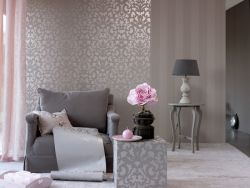 Harmony Of Color That What Friends
Harmony Of Color That What Friends